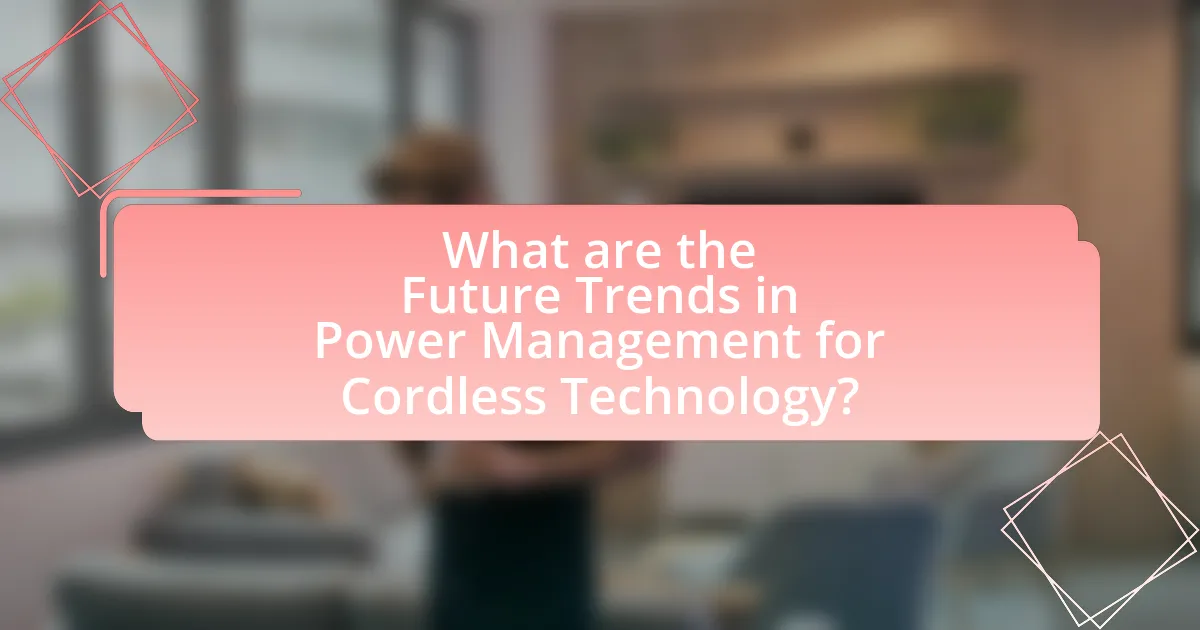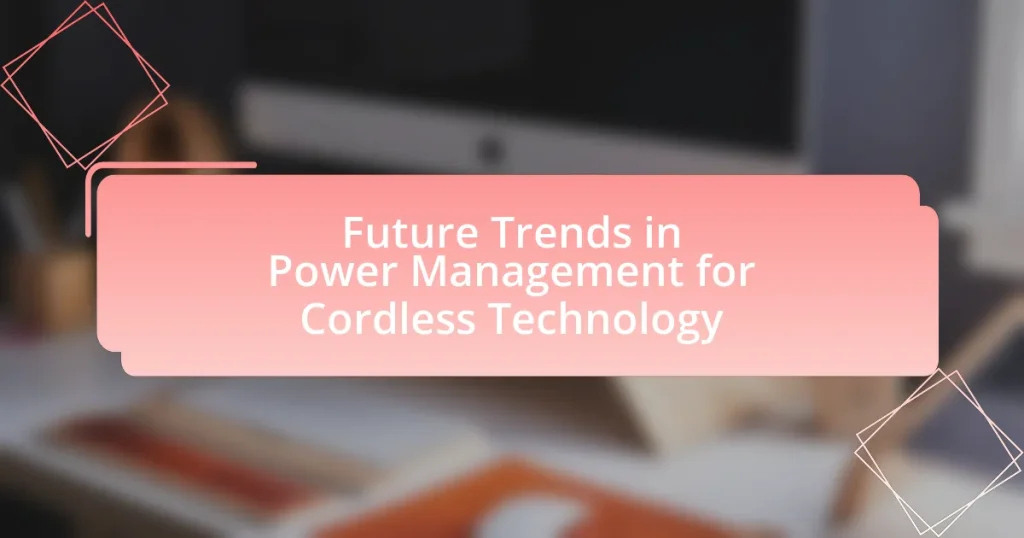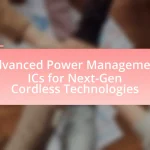The article focuses on future trends in power management for cordless technology, highlighting advancements in battery efficiency, energy harvesting technologies, and smart power management systems. Key developments include innovations in lithium-sulfur and solid-state batteries, which promise higher energy densities and longer lifespans. The increasing demand for cordless devices drives the need for improved energy storage solutions and efficient power management strategies, including smart charging systems that adapt to user behavior. Additionally, the article discusses the environmental implications of energy-efficient designs and the evolving industry standards that shape product development and consumer safety in the context of power management.

What are the Future Trends in Power Management for Cordless Technology?
Future trends in power management for cordless technology include advancements in battery efficiency, integration of energy harvesting technologies, and the development of smart power management systems. Battery efficiency is expected to improve through innovations in lithium-sulfur and solid-state batteries, which can offer higher energy densities and longer lifespans compared to traditional lithium-ion batteries. Energy harvesting technologies, such as solar and kinetic energy converters, are being integrated into cordless devices to extend operational time without frequent recharging. Additionally, smart power management systems utilizing artificial intelligence will optimize energy consumption by dynamically adjusting power usage based on real-time data, enhancing the overall performance and sustainability of cordless technology. These trends are supported by ongoing research and development efforts in the fields of materials science and energy systems, indicating a significant shift towards more efficient and sustainable cordless solutions.
How is the demand for cordless technology influencing power management trends?
The demand for cordless technology is significantly influencing power management trends by driving the development of more efficient energy storage solutions and advanced power management systems. As consumers increasingly prefer cordless devices for their convenience, manufacturers are compelled to innovate in battery technology, leading to the creation of high-capacity, fast-charging batteries that enhance device performance. For instance, the global market for lithium-ion batteries, which are essential for cordless technology, is projected to reach $129.3 billion by 2027, reflecting a compound annual growth rate of 18.0% from 2020 to 2027. This surge in demand necessitates improved power management strategies to optimize battery life and energy efficiency, resulting in the integration of smart charging systems and energy harvesting technologies that adapt to user behavior and environmental conditions.
What consumer behaviors are driving the need for improved power management?
Consumer behaviors driving the need for improved power management include the increasing demand for energy-efficient devices and the growing reliance on portable technology. As consumers prioritize sustainability, they seek products that minimize energy consumption, leading manufacturers to innovate in power management solutions. Additionally, the rise in remote work and mobile lifestyles has heightened the need for longer battery life and efficient charging systems in cordless devices. According to a report by the International Energy Agency, energy efficiency improvements in consumer electronics can significantly reduce global energy demand, underscoring the importance of enhanced power management in meeting consumer expectations.
How do advancements in battery technology impact power management strategies?
Advancements in battery technology significantly enhance power management strategies by increasing energy density and efficiency. Higher energy density allows devices to operate longer on a single charge, reducing the frequency of recharging and optimizing energy use. For instance, lithium-sulfur batteries can achieve up to five times the energy density of traditional lithium-ion batteries, enabling more efficient power management in portable devices. Additionally, improvements in battery life and charging speed lead to smarter power management systems that can dynamically adjust energy consumption based on battery status, ultimately prolonging device lifespan and performance.
What role does energy efficiency play in future power management trends?
Energy efficiency is crucial in shaping future power management trends by reducing energy consumption and operational costs. As global energy demands rise, efficient power management systems will prioritize technologies that minimize waste and optimize resource use. For instance, the International Energy Agency reported that improving energy efficiency could lead to a 40% reduction in global energy demand by 2040, highlighting its significant impact on sustainability and economic viability. This trend is further supported by advancements in smart grid technologies and energy storage solutions, which enhance the integration of renewable energy sources and improve overall system reliability.
How can energy-efficient designs enhance the performance of cordless devices?
Energy-efficient designs enhance the performance of cordless devices by optimizing power consumption, which extends battery life and improves overall functionality. These designs incorporate advanced technologies such as low-power components, energy harvesting, and smart power management systems that reduce energy waste. For instance, using energy-efficient processors can decrease the energy required for processing tasks, allowing devices to operate longer on a single charge. Additionally, energy-efficient designs often include features like adaptive power scaling, which adjusts the device’s power usage based on current demands, further enhancing performance while conserving energy. This approach not only prolongs battery life but also contributes to a more sustainable use of resources in cordless technology.
What are the environmental implications of energy-efficient power management?
Energy-efficient power management significantly reduces environmental impacts by lowering energy consumption and greenhouse gas emissions. Implementing energy-efficient technologies can decrease the demand for fossil fuels, which are major contributors to air pollution and climate change. For instance, according to the U.S. Department of Energy, energy efficiency improvements in buildings and appliances could reduce carbon dioxide emissions by 1.5 billion metric tons annually by 2030. Additionally, energy-efficient power management minimizes waste generation and resource depletion, promoting sustainability. This approach not only conserves energy but also enhances the longevity of natural resources, contributing to a healthier ecosystem.
What innovations are shaping the future of power management in cordless technology?
Innovations shaping the future of power management in cordless technology include advanced battery chemistry, energy harvesting techniques, and smart power management systems. Advanced battery chemistry, such as lithium-sulfur and solid-state batteries, offers higher energy densities and longer lifespans compared to traditional lithium-ion batteries, enhancing the performance of cordless devices. Energy harvesting techniques, like solar and kinetic energy conversion, enable devices to recharge using ambient energy, reducing reliance on traditional power sources. Smart power management systems utilize artificial intelligence and machine learning to optimize energy consumption, extending battery life and improving efficiency. These innovations collectively contribute to more sustainable and efficient cordless technology solutions.
How are smart technologies influencing power management solutions?
Smart technologies are significantly enhancing power management solutions by enabling real-time monitoring and optimization of energy consumption. These technologies, such as IoT devices and AI algorithms, facilitate data-driven decision-making, allowing for more efficient energy use and reduced waste. For instance, smart meters provide detailed insights into energy usage patterns, which can lead to better load management and demand response strategies. According to a report by the International Energy Agency, implementing smart grid technologies can improve energy efficiency by up to 30%, demonstrating their substantial impact on power management.
What emerging technologies are expected to revolutionize power management?
Emerging technologies expected to revolutionize power management include advanced battery technologies, smart grid systems, and energy harvesting solutions. Advanced battery technologies, such as solid-state batteries, offer higher energy densities and improved safety compared to traditional lithium-ion batteries, which can enhance the efficiency of cordless devices. Smart grid systems utilize real-time data and automation to optimize energy distribution and consumption, leading to more efficient power management across various applications. Energy harvesting technologies, such as piezoelectric and thermoelectric systems, convert ambient energy into usable power, reducing reliance on traditional energy sources. These innovations are supported by research indicating that solid-state batteries can increase energy density by up to 50%, while smart grids can reduce energy losses by 30% through improved management practices.

How are Industry Standards Evolving for Power Management in Cordless Technology?
Industry standards for power management in cordless technology are evolving towards greater efficiency and sustainability. Recent developments focus on implementing advanced battery management systems (BMS) that optimize energy usage and extend battery life, with standards such as IEC 62133 guiding safety and performance. Additionally, the integration of smart technologies, including IoT and AI, is enhancing real-time monitoring and adaptive power management, ensuring devices operate at optimal efficiency. These advancements are supported by industry collaborations, such as the Wireless Power Consortium, which promotes interoperability and standardization in wireless charging technologies, further driving innovation in power management solutions.
What are the current industry standards for power management in cordless devices?
The current industry standards for power management in cordless devices focus on energy efficiency, battery longevity, and smart power management systems. These standards are guided by protocols such as IEEE 802.15.4 for low-power wireless communication, which emphasizes minimal energy consumption while maintaining connectivity. Additionally, the implementation of advanced battery management systems (BMS) ensures optimal charging cycles and extends battery life, adhering to standards set by organizations like the International Electrotechnical Commission (IEC) and the Institute of Electrical and Electronics Engineers (IEEE). These standards are crucial for enhancing the performance and sustainability of cordless devices in various applications.
How do these standards affect product development and consumer safety?
Standards significantly influence product development and consumer safety by establishing benchmarks for quality, performance, and safety protocols. These standards guide manufacturers in designing products that meet regulatory requirements, thereby reducing the risk of defects and ensuring that products are safe for consumer use. For instance, compliance with safety standards such as IEC 62368-1 for audio/video, information, and communication technology equipment ensures that products are tested for electrical safety and fire hazards, which directly protects consumers from potential harm. Additionally, adherence to environmental standards, like RoHS, mandates the reduction of hazardous substances in products, further enhancing consumer safety and promoting sustainable practices in product development.
What challenges do manufacturers face in meeting these standards?
Manufacturers face several challenges in meeting power management standards for cordless technology, primarily due to the rapid pace of technological advancements and regulatory changes. These challenges include the need for continuous innovation to comply with evolving efficiency standards, which can require significant investment in research and development. Additionally, manufacturers must navigate complex supply chain issues, as sourcing high-quality materials that meet these standards can be difficult and costly. Furthermore, the integration of new technologies, such as advanced battery management systems, often requires specialized knowledge and expertise, which may not be readily available within the existing workforce. These factors collectively hinder manufacturers’ ability to consistently meet the required standards in a competitive market.
How are regulatory changes impacting power management practices?
Regulatory changes are significantly impacting power management practices by enforcing stricter energy efficiency standards and promoting the adoption of renewable energy sources. These regulations compel manufacturers to innovate and implement advanced power management technologies, such as smart grids and energy storage systems, to comply with new efficiency benchmarks. For instance, the Energy Policy Act of 2005 and subsequent regulations have led to a marked increase in the development of energy-efficient devices, resulting in a 30% reduction in energy consumption in certain sectors. This shift not only enhances sustainability but also drives economic benefits through reduced operational costs and increased competitiveness in the market.
What recent regulations have been introduced regarding energy consumption?
Recent regulations introduced regarding energy consumption include the European Union’s Ecodesign Directive, which mandates stricter energy efficiency standards for various appliances and electronic devices. This directive aims to reduce energy consumption and greenhouse gas emissions by enforcing minimum efficiency requirements and promoting the use of sustainable materials. Additionally, the U.S. Department of Energy has implemented new energy conservation standards for residential appliances, which are projected to save consumers billions in energy costs while significantly lowering overall energy usage. These regulations reflect a global trend towards enhancing energy efficiency and reducing environmental impact.
How can companies adapt to these regulatory changes effectively?
Companies can adapt to regulatory changes effectively by implementing a proactive compliance strategy that includes continuous monitoring of regulations, employee training, and investment in technology. Continuous monitoring allows companies to stay informed about new regulations and adjust their practices accordingly. Employee training ensures that staff understand compliance requirements and can implement them in daily operations. Investment in technology, such as automated compliance management systems, can streamline processes and reduce the risk of non-compliance. For instance, a study by the International Compliance Association found that organizations with robust compliance programs are 50% less likely to face regulatory penalties.

What are the Key Challenges in Power Management for Cordless Technology?
The key challenges in power management for cordless technology include limited battery life, energy efficiency, and thermal management. Limited battery life restricts the usability of cordless devices, as users require longer operational periods without frequent recharging. Energy efficiency is crucial, as devices must optimize power consumption to extend battery life while maintaining performance. Thermal management is also a significant challenge, as excessive heat can degrade battery performance and lifespan. These challenges necessitate ongoing advancements in battery technology, energy harvesting methods, and efficient power management systems to enhance the overall functionality and user experience of cordless devices.
What technical challenges do developers face in power management?
Developers face several technical challenges in power management, including optimizing energy efficiency, managing thermal performance, and ensuring battery longevity. Energy efficiency is critical as developers must balance performance with power consumption, often requiring complex algorithms to minimize energy use without sacrificing functionality. Managing thermal performance is essential because excessive heat can lead to hardware failure; thus, developers must implement effective cooling solutions and thermal management strategies. Additionally, ensuring battery longevity poses a challenge, as developers need to design systems that can intelligently manage charging cycles and power distribution to extend battery life while maintaining user experience. These challenges are compounded by the rapid evolution of technology, which demands continuous adaptation and innovation in power management solutions.
How do battery life and charging times affect user experience?
Battery life and charging times significantly impact user experience by influencing device usability and satisfaction. Longer battery life allows users to engage with their devices for extended periods without interruption, enhancing productivity and convenience. For instance, a smartphone with a battery life of 12 hours enables users to complete tasks throughout the day without needing to recharge, while a device with only 4 hours of battery life may lead to frustration and decreased usability.
Additionally, faster charging times improve user experience by minimizing downtime. Devices that can charge to 50% in 30 minutes, like many modern smartphones, allow users to quickly regain functionality, which is crucial in fast-paced environments. Research indicates that 70% of users prefer devices that can charge rapidly, as it aligns with their on-the-go lifestyles. Therefore, both battery longevity and efficient charging directly correlate with user satisfaction and overall device performance.
What are the limitations of current power management technologies?
Current power management technologies face several limitations, including inefficiency in energy conversion, limited scalability, and inadequate integration with renewable energy sources. For instance, traditional power management systems often convert only about 80-90% of energy, resulting in wasted power. Additionally, many existing technologies struggle to scale effectively for diverse applications, particularly in the rapidly evolving cordless technology sector. Furthermore, the integration of renewable energy sources, such as solar and wind, remains challenging due to inconsistent energy supply and the need for advanced storage solutions. These limitations hinder the overall effectiveness and sustainability of power management systems in modern applications.
What market challenges are influencing power management strategies?
Market challenges influencing power management strategies include increasing energy costs, regulatory pressures for energy efficiency, and the demand for longer battery life in cordless technology. These factors compel companies to innovate and adopt advanced power management solutions to remain competitive. For instance, the International Energy Agency reported that global energy prices have surged, prompting businesses to seek more efficient energy usage. Additionally, regulations such as the Energy Efficiency Directive in the European Union require manufacturers to enhance the energy performance of their products, further driving the need for effective power management strategies. Lastly, consumer expectations for longer-lasting batteries in devices push manufacturers to invest in research and development for improved power management technologies.
How does competition among manufacturers impact innovation in power management?
Competition among manufacturers significantly drives innovation in power management by incentivizing the development of more efficient and advanced technologies. As companies strive to differentiate their products and capture market share, they invest in research and development to create innovative solutions that enhance energy efficiency, reduce costs, and improve performance. For instance, the push for longer battery life and faster charging times in cordless devices has led to breakthroughs in battery technology and power management systems. According to a report by MarketsandMarkets, the global power management IC market is projected to grow from $23.5 billion in 2020 to $36.5 billion by 2025, highlighting the impact of competitive pressures on innovation in this sector.
What economic factors are affecting investment in power management technologies?
Investment in power management technologies is primarily affected by factors such as energy prices, government policies, and market demand for energy efficiency. Fluctuating energy prices can drive companies to invest in technologies that reduce consumption and costs. For instance, the International Energy Agency reported that rising energy costs have led to increased investments in energy-efficient technologies, as businesses seek to mitigate expenses. Additionally, supportive government policies, such as tax incentives and subsidies for renewable energy projects, encourage investment in power management solutions. According to a report by the U.S. Department of Energy, such policies have significantly boosted funding for energy-efficient technologies. Lastly, growing market demand for sustainable and efficient energy solutions compels companies to adopt advanced power management technologies to remain competitive, as highlighted by a study from McKinsey & Company, which found that businesses prioritizing energy efficiency see improved profitability and market positioning.
What best practices can be adopted for effective power management in cordless technology?
Effective power management in cordless technology can be achieved by implementing strategies such as optimizing battery usage, utilizing energy-efficient components, and incorporating smart charging systems. Optimizing battery usage involves monitoring and controlling power consumption through software algorithms that adjust performance based on user needs, which can extend battery life significantly. Energy-efficient components, such as low-power processors and LED indicators, reduce overall energy demand, contributing to longer operational times. Smart charging systems, including adaptive charging techniques, can enhance battery longevity by preventing overcharging and managing charge cycles effectively. These practices are supported by research indicating that energy-efficient designs can reduce power consumption by up to 30%, thereby improving the sustainability of cordless devices.
How can manufacturers optimize battery performance in their products?
Manufacturers can optimize battery performance in their products by implementing advanced battery management systems (BMS) that monitor and control charging and discharging processes. These systems enhance battery life and efficiency by preventing overcharging and deep discharging, which can degrade battery capacity. Research indicates that effective BMS can increase battery lifespan by up to 30% by maintaining optimal operating conditions. Additionally, manufacturers can utilize high-energy-density materials, such as lithium-silicon anodes, which have been shown to improve energy capacity significantly compared to traditional lithium-ion batteries. This combination of advanced management systems and innovative materials directly contributes to enhanced battery performance in cordless technology applications.
What strategies can consumers use to maximize the lifespan of cordless devices?
Consumers can maximize the lifespan of cordless devices by following proper charging practices, maintaining optimal operating conditions, and performing regular maintenance. Proper charging involves avoiding overcharging and using the manufacturer’s recommended charger, as overcharging can lead to battery degradation. Maintaining optimal operating conditions includes keeping devices away from extreme temperatures and humidity, which can negatively affect battery performance. Regular maintenance, such as cleaning contacts and ensuring proper storage when not in use, can also enhance the longevity of cordless devices. These strategies are supported by battery care guidelines from manufacturers, which emphasize the importance of these practices in extending battery life.


